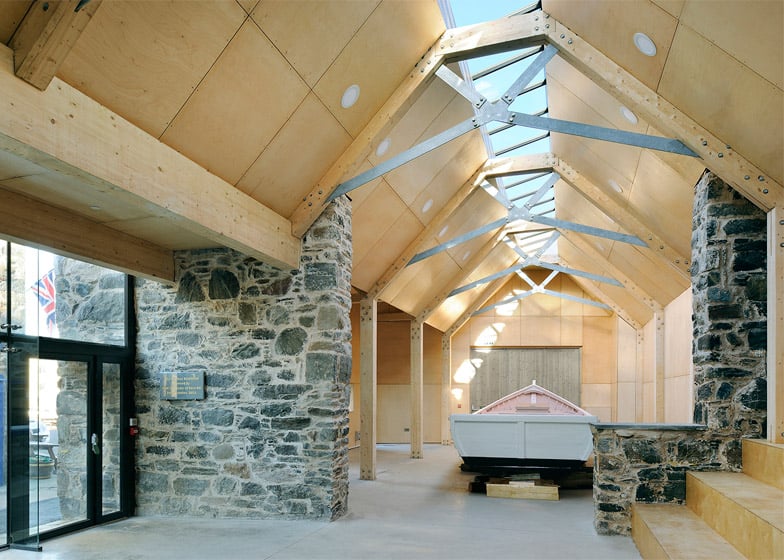Children and adults learn the skills of boatbuilding inside this harbour-side stone structure that Scottish firm Brown + Brown has updated with a contemporary wooden roof.
Aberdeen-based Brown + Brown designed the facility for Portsoy, a village on Scotland's north coast. It occupies the only two blocks in the historic harbour that aren't heritage-listed, both of which were formerly derelict and in dire need of renovation.
"One was completely ruinous, while the other had a ramshackle tin roof, and was used to store the odd rowing boat and junk," explained architect and studio co-founder Andrew Brown. "But you could see the potential in their original stonework."
The brief was for a community boatbuilding centre to be run by the Scottish Traditional Boat Festival, a local charity. The requirements were for it to be robust and hardwearing, but also to fit in with its setting and offer enough space for its purpose.
The team chose to create a new structure that slots into the existing stone walls. This allowed them to create a contemporary wooden interior that is largely undetectable from the outside.
"From the initial concepts, we worked on the idea of sliding a modern building inside a repaired stone skin," Brown told Dezeen.
"We wanted to create a warm interior that would contrast with the hard stone, which obviously has to deal with the extreme weather of its coastal location," he said.
There were very few windows, but rather than punching holes through the stonework, the team though it would be better to create a skylight that runs along the length of the roof. This ensures the space receives plenty of daylight.
"The only part of the external elevations that hints at the modern interior is the glazed curtain wall, which spans the empty space that previously existed between the two ruins, and provides an entrance and focal point to allow visitors and tourists to observe the boatbuilding taking place within," added the architect.
The Portsoy Boatbuilding Centre was funded by three bodies: Aberdeenshire Council, Historic Scotland, and the Aberdeen European Fisheries Fund.
The budget was tight, but volunteers from the charity helped to build the new wooden structure. It comprises both glue-laminated beams and plywood panels – materials that the workers were already familiar with using.
"This was very important as it helped the clients feel a sense of ownership of the space – not only did they partially construct it, but they are capable of altering and adapting it to suit the needs of their boatbuilding," added Brown.
Other recent examples of workshop buildings include a Cambridge shed built to the proportions of a hand-me-down workbench and a university model-making studio with walls that fold open.
Photography is by Nigel Rigden.

